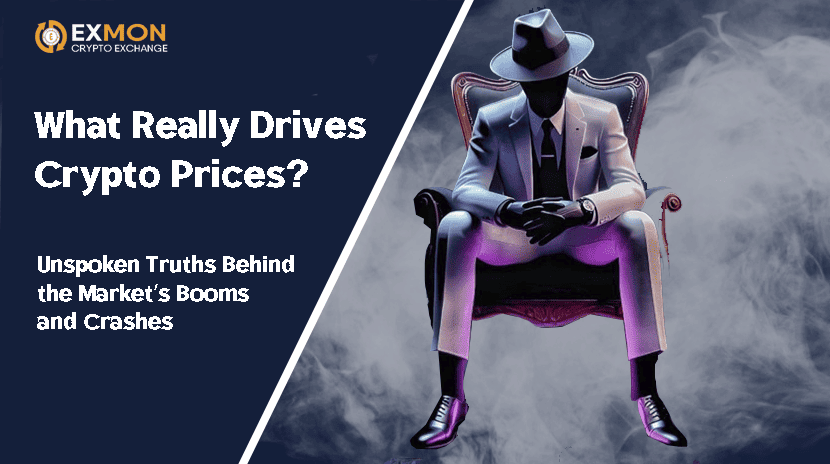The crypto market isn’t just about charts, indicators, and technical patterns. It’s much deeper, more complex, and a whole lot dirtier. Most public analysts, influencers, and so-called "experts" tell the masses about "supply and demand," "halvings," and "news cycles." While these factors matter, the real game is played behind closed doors—through insider moves, market manipulation, controlled liquidity, and geopolitical-financial intrigues. Let’s break down what actually drives the crypto market.
1. Controlled Liquidity: How Whales and Market Makers Manipulate Prices
Most traders believe that price is determined by the natural balance of supply and demand. But in crypto, the reality is very different. Liquidity is controlled by major players—market makers, exchanges, hedge funds, and shadow entities that coordinate to influence price action.
How It Works:
- Exchange Algorithms & HFT Bots – High-frequency trading (HFT) bots manipulate liquidity, create fake signals, and hunt stop-losses.
- Coordinated Pumps & Dumps – Whales collude to move the market at strategic moments, while retail traders unknowingly jump on board.
- Fake Orders (Spoofing & Layering) – Large buy/sell orders are placed and instantly removed to create the illusion of demand or supply.
Example:
Before major Bitcoin price moves (like the 2021 bull run), fake order walls appeared on exchanges and disappeared within seconds—classic market deception.
2. Stablecoins: The Silent Market Movers
USDT, USDC, BUSD—people think of them as simple digital dollars, but they are actually powerful market control tools.
What No One Talks About:
- USDT issuance often coincides with BTC price surges. Billions of stablecoins are injected into the market at key moments to drive up prices.
- USDT’s reserves remain a black box. No one truly knows what backs Tether, but it clearly wields more market influence than any other entity.
- Stablecoins matter more than BTC itself. A major USDT collapse could bring down the entire crypto market—so it’s in powerful hands to ensure that never happens.
Example:
In 2017 and 2020, massive USDT inflows coincided with Bitcoin’s biggest bull runs.
3. Geopolitics & Regulation: The Hidden Hands Controlling Crypto
Forget the idea of a “decentralized market.” Crypto is already in the grip of governments, banks, and institutional players.
How It’s Happening:
- SEC & Crackdowns on Key Players – Ripple, Binance, and Kraken face constant scrutiny, while BlackRock’s BTC ETF gets fast-tracked.
- Nation-Level Manipulations – China has "banned" crypto multiple times, yet its capital floods the market first. The US plays regulatory hardball but pushes institutional adoption.
- Sanctions & Shadow Markets – Russia, Iran, and North Korea use crypto to bypass sanctions, creating hidden liquidity.
Example:
After Russia’s invasion of Ukraine, stablecoin usage in gray-market transactions surged, yet mainstream analysts rarely discuss these market-moving factors.
4. Institutional Control: ETFs & Hedge Funds Own the Game
Retail traders celebrate news of institutional adoption, but they don’t realize that these big players aren’t just "buying BTC"—they’re taking control of the market.
How They Operate:
- Grayscale & BlackRock accumulate, not invest. Their goal is to control supply and dictate price action.
- Banks already own massive crypto positions. The real play is market monopolization.
- Buying at rock-bottom prices. When retail panic-sells, institutions buy cheap, then drive prices back up to dump on the next wave of retail investors.
Example:
In 2022, BTC fell below $20,000. OTC desks quietly bought up supply—then drove prices past $30,000 within months.
5. News & Media: The Ultimate Market Manipulation Tool
Major crypto news events aren’t coincidences—they’re orchestrated to trigger market moves.
How It Works:
- Bullish news at market tops → Retail FOMO, whales exit.
- Bearish news at market bottoms → Panic selling, whales buy.
- Planned FUD campaigns – Before FTX collapsed, coordinated media leaks primed the market for a dump.
Example:
In 2021, BTC hit $60,000+ right before Tesla announced it was accepting Bitcoin. Weeks later, Musk reversed the decision, triggering a market crash.
6. Open Interest, Liquidations & Wiping Out Leverage Traders
Massive market moves often happen when open interest (OI) in futures markets reaches extreme levels.
How It Works:
- Retail traders pile into long positions → Market dumps, liquidating leveraged longs.
- Retail traders short heavily → Sudden pump wipes out short sellers.
- Stop-loss hunting before major moves – Market makers trigger forced liquidations before a big rally.
Example:
In June 2023, before BTC pumped from $25,000 to $30,000, millions of dollars in short positions were liquidated.
Conclusion: The Market Is Rigged—Learn to Play It Right
The crypto market isn’t chaotic—it’s a controlled system dominated by market makers, hedge funds, and political forces. What retail traders see is just a reflection of the real game happening behind the scenes.
Understanding these mechanics isn’t just about making money—it’s about surviving and avoiding being a victim of manipulation.
Trading against the herd means understanding how the market really moves.


